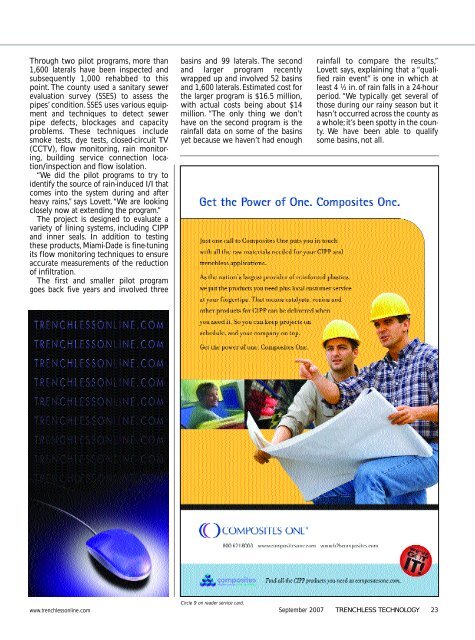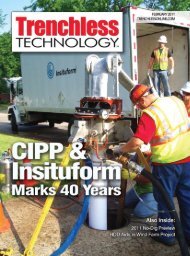Author: Professor, Dr. Dietrich Stein - TrenchlessOnline
Author: Professor, Dr. Dietrich Stein - TrenchlessOnline
Author: Professor, Dr. Dietrich Stein - TrenchlessOnline
Create successful ePaper yourself
Turn your PDF publications into a flip-book with our unique Google optimized e-Paper software.
Through two pilot programs, more than<br />
1,600 laterals have been inspected and<br />
subsequently 1,000 rehabbed to this<br />
point. The county used a sanitary sewer<br />
evaluation survey (SSES) to assess the<br />
pipes’ condition. SSES uses various equipment<br />
and techniques to detect sewer<br />
pipe defects, blockages and capacity<br />
problems. These techniques include<br />
smoke tests, dye tests, closed-circuit TV<br />
(CCTV), flow monitoring, rain monitoring,<br />
building service connection location/inspection<br />
and flow isolation.<br />
“We did the pilot programs to try to<br />
identify the source of rain-induced I/I that<br />
comes into the system during and after<br />
heavy rains,” says Lovett.“We are looking<br />
closely now at extending the program.”<br />
The project is designed to evaluate a<br />
variety of lining systems, including CIPP<br />
and inner seals. In addition to testing<br />
these products, Miami-Dade is fine-tuning<br />
its flow monitoring techniques to ensure<br />
accurate measurements of the reduction<br />
of infiltration.<br />
The first and smaller pilot program<br />
goes back five years and involved three<br />
www.trenchlessonline.com<br />
basins and 99 laterals. The second<br />
and larger program recently<br />
wrapped up and involved 52 basins<br />
and 1,600 laterals.Estimated cost for<br />
the larger program is $16.5 million,<br />
with actual costs being about $14<br />
million. “The only thing we don’t<br />
have on the second program is the<br />
rainfall data on some of the basins<br />
yet because we haven’t had enough<br />
Circle 9 on reader service card.<br />
rainfall to compare the results,”<br />
Lovett says, explaining that a “qualified<br />
rain event” is one in which at<br />
least 4 ½ in. of rain falls in a 24-hour<br />
period. “We typically get several of<br />
those during our rainy season but it<br />
hasn’t occurred across the county as<br />
a whole;it’s been spotty in the county.<br />
We have been able to qualify<br />
some basins, not all.<br />
September 2007 TRENCHLESS TECHNOLOGY 23








